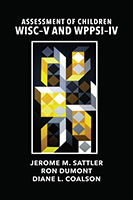|
|
JEROME M. SATTLER, PUBLISHER, INC. |
|||
|
COMPLETE TABLE OF CONTENTS
Chapter 1. Role of the Evaluator in the Assessment Process 1 Evaluator Characteristics 2 Preparing for the First Meeting 8 Establishing Rapport 10 Observing Children 14 General Suggestions for Administering Tests 25 Administering Tests to Children with Special Needs 36 Computer-Based Administration, Scoring, and Interpretation 39 Accounting for Poor Test Performance 41 Strategies for Becoming an Effective Evaluator 42 Confidentiality of Assessment Findings and Records 43 Concluding Comment on the Role of the Evaluator in the Assessment Process 45 Thinking Through the Issues 46 Summary 47 Key Terms, Concepts, and Names 52 Study Questions 53
Chapter 2. Wechsler Intelligence Scale for Children–Fifth Edition (WISC–V): Description 55 A Note About Terminology 61 Standardization 61 Standard Scores, Scaled Scores, and Age Equivalents 62 Reliability 63 Validity 71 Intercorrelations for Subtests and Index Scales 76 Factor Analysis 76 Range of Subtest Scaled Scores 83 Range of Primary, Ancillary, and Complementary Index Scores 84 Range of FSIQs 84 Guidelines for Computing Index Scores and FSIQs 84 Administering the WISC–V 85 Short Forms 97 Subtest Scatter 98 Choosing Between the WISC–V and the WPPSI–IV or the WAIS–IV 98 Administering the WISC–V to Children with Disabilities 98 Strengths of the WISC–V 100 Limitations of the WISC–V 100 Concluding Comment 101 Thinking Through the Issues 101 Summary 101 Key Terms, Concepts, and Names 105 Study Questions 105
Chapter 3. WISC–V Subtests 107 Block Design 109 Similarities 113 Matrix Reasoning 116 Digit Span 118 Coding 122 Vocabulary 125 Figure Weights 129 Visual Puzzles 131 Picture Span 134 Symbol Search 136 Information 140 Picture Concepts 142 Letter–Number Sequencing 145 Cancellation 147 Naming Speed Literacy 150 Naming Speed Quantity 153 Immediate Symbol Translation 156 Comprehension 158 Arithmetic 160 Delayed Symbol Translation 163 Recognition Symbol Translation 165 Thinking Through the Issues 167 Summary 167 Key Terms, Concepts, and Names 169 Study Questions 169
Chapter 4. Interpreting the WISC–V 171 FSIQ 172 Primary Indexes 172 Ancillary Indexes 173 Complementary Indexes 175 Profile Analysis 175 Comment on Profile Analysis 198 A Successive-Level Approach to Test Interpretation 198 Steps in Analyzing a Protocol 199 Estimated Percentile Ranks and Age Equivalents for Total Raw Scores 200 Comment on Interpreting the WISC–V 201 Thinking Through the Issues 201 Summary 202 Key Terms, Concepts, and Names 205 Study Questions 205
Chapter 5. Wechsler Preschool and Primary Scale of Intelligence–Fourth Edition (WPPSI–IV): Description 207 A Note About Terminology 213 Standardization 213 Standard Scores, Scaled Scores, and Age Equivalents 214 Reliability 214 Validity 218 Intercorrelations for Subtests and Scales 221 Factor Analysis 224 Range of Subtest Scaled Scores 232 Range of FSIQs 232 Guidelines for Computing Index Scores and FSIQs 232 Administering the WPPSI–IV 233 Short Forms 243 Subtest Scatter 245 Choosing Between the WPPSI–IV and the WISC–V 245 Administering the WPPSI–IV to Children with Disabilities 245 Strengths of the WPPSI–IV 246 Limitations of the WPPSI–IV 247 Concluding Comment 247 Thinking Through the Issues 248 Summary 248 Key Terms, Concepts, and Names 251 Study Questions 251
Chapter 6. WPPSI–IV Subtests 253 Block Design 254 Information 259 Matrix Reasoning 262 Bug Search 264 Picture Memory 266 Similarities 268 Picture Concepts 271 Cancellation 274 Zoo Locations 276 Object Assembly 278 Vocabulary 281 Animal Coding 284 Comprehension 286 Receptive Vocabulary 289 Picture Naming 291 Thinking Through the Issues 293 Summary 293 Key Terms, Concepts, and Names 294 Study Questions 295
Chapter 7. Interpreting the WPPSI–IV 297 The FSIQ and Index Scores 298 Profile Analysis 300 Comment on Profile Analysis 318 A Successive-Level Approach to Test Interpretation 319 Steps in Analyzing a Protocol 320 Estimated Percentile Ranks and Age Equivalents for Total Raw Scores 320 Comment on Interpreting the WPPSI–IV 321 Thinking Through the Issues 321 Summary 322 Key Terms, Concepts, and Names 324 Study Questions 324
Chapter 8. Report Writing 325 Introduction to Psychological Report Writing 326 Sections of a Psychological Report 332 Principles of Report Writing 339 Concluding Comment on Report Writing 364 Thinking Through the Issues 368 Summary 368 Key Terms, Concepts, and Names 369 Study Questions 370
Appendixes A. Tables for the WISC–V 371 B. Tables for the WPPSI–IV 423 C. Tables for the WISC–V and WPPSI–IV 473
References 519 Name Index 522 Subject Index 523
|

